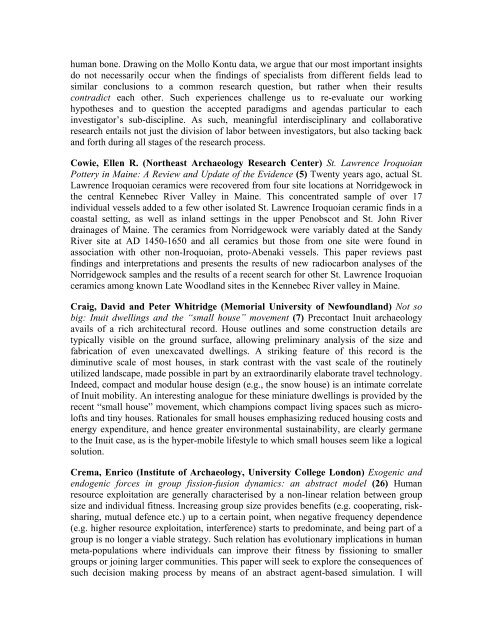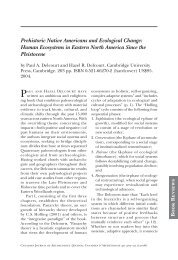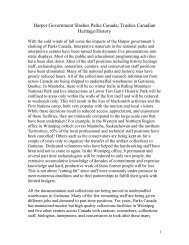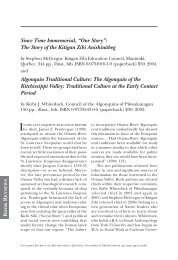in single households. Given that the house is a fundamental space in Inuit daily life, it ispossible to assume that this architectural transition reflects a significant change in theorganization, economy and patterns of social interaction of Labrador Inuit communities.Using a geoarchaeological approach, we intend to document the spatial configuration ofthese “communal” houses. Sedimentological, micromorphological and geochemicalanalyses are used to i<strong>de</strong>ntify the location of different activity areas within communalhouses in the Okak Bay and Nain regions of Labrador. We will compare our results with<strong>de</strong>scriptions of this type of dwelling drawn from anthropological, historical andarchaeological sources. Through these analyses, we hope to refine the application ofgeoarchaeological methods to the study of households and of domestic space.Géoarchéologie <strong>de</strong> la maisonnée : Étu<strong>de</strong> <strong>de</strong> l’organisation spatiale <strong>de</strong>s maisonscommunautaires inuites <strong>de</strong> la pério<strong>de</strong> <strong>de</strong> contact au Labrador Vers la fin du 17e siècle,les communautés inuites du Labrador ont commencé à vivre dans <strong>de</strong> gran<strong>de</strong>s maisonssemi-souterraines dans lesquelles plusieurs familles nucléaires composaient unemaisonnée. Puisque la maison représente un espace fondamental dans la culture <strong>de</strong> cescommunautés, cette transition architecturale a probablement engendré <strong>de</strong>s changementsmajeurs dans leur organisation, leur économie et leurs mo<strong>de</strong>s d’interactions sociales. Àl’ai<strong>de</strong> d’une approche géoarchéologique, nous tentons <strong>de</strong> documenter la configurationinterne <strong>de</strong> ces maisons « communautaires ». Des analyses sédimentologiques,micromorphologiques et géochimiques sont utilisées pour i<strong>de</strong>ntifier la localisation d’airesd’activités au sein <strong>de</strong> maisons communautaires <strong>de</strong> la baie d’Okak et <strong>de</strong> la région <strong>de</strong> Nainau Labrador. Nous projetons comparer nos résultats avec les <strong>de</strong>scriptions faites <strong>de</strong> ce typed’habitation dans les sources anthropologiques, historiques et archéologiques. Par le biais<strong>de</strong> cette recherche, nous espérons établir davantage la pertinence <strong>de</strong>s métho<strong>de</strong>sgéoarchéologiques dans l’étu<strong>de</strong> <strong>de</strong> la maisonnée et <strong>de</strong> l’espace domestique.Couture, Cathy (Arkéos inc.) Apport <strong>de</strong>s interventions menées en 2011 par la firmeArkéos inc. sur l’histoire du noyau villageois <strong>de</strong> Pointe-aux-Trembles (BjFi-16) (31)Dans le cadre d’une réfection <strong>de</strong>s réseaux d’aqueduc et d’égout <strong>de</strong> la Ville <strong>de</strong> Montréal,la firme Arkéos inc a mené une intervention archéologique à l’été 2011 dans le cœur dunoyau villageois <strong>de</strong> Pointe-aux-Trembles (BjFi-16), un espace où le développementhistorique s’amorce à la fin du XVIIe siècle. Les travaux visaient à documenter le frontbâti <strong>de</strong>s terrains situés du côté est <strong>de</strong> l’ancienne rue Saint-Jean-Baptiste, un espace qui aété intégrée au domaine public suite à l’élargissement <strong>de</strong> la rue en 1914. Les résultats,couplés aux autres données archéologiques disponibles (<strong>de</strong> 2009 et <strong>de</strong> 2010) ainsi qu’à ladocumentation historique, ont entre autres permis <strong>de</strong> mieux préciser l’organisation dumilieu naturel <strong>de</strong>s lieux avant 1690, la limite <strong>de</strong> la faça<strong>de</strong> <strong>de</strong>s premiers lots concédés en1693 et, dans une certaine mesure, l’utilisation du sol au cours du Régime français.Couture, Nicole C., Maria C. Bruno, and Deborah E. Blom (The University ofMcGill) Truth and reconciliation at Tiwanaku: coming to terms with contradiction ininterdisciplinary archaeological research (1) Since 2005 the authors have co-directed aninterdisciplinary field project focused on the intensive study of the Mollo Kontu urbanneighborhood at the site of Tiwanaku in highland Bolivia; this research inclu<strong>de</strong>stopographic mapping, pe<strong>de</strong>strian and remote sensing surveys, and excavations, as well aslaboratory analysis of both micro and macrofauna, ceramics, macrobotanical remains, and
human bone. Drawing on the Mollo Kontu data, we argue that our most important insightsdo not necessarily occur when the findings of specialists from different fields lead tosimilar conclusions to a common research question, but rather when their resultscontradict each other. Such experiences challenge us to re-evaluate our workinghypotheses and to question the accepted paradigms and agendas particular to eachinvestigator’s sub-discipline. As such, meaningful interdisciplinary and collaborativeresearch entails not just the division of labor between investigators, but also tacking backand forth during all stages of the research process.Cowie, Ellen R. (Northeast Archaeology Research Center) St. Lawrence IroquoianPottery in Maine: A Review and Update of the Evi<strong>de</strong>nce (5) Twenty years ago, actual St.Lawrence Iroquoian ceramics were recovered from four site locations at Norridgewock inthe central Kennebec River Valley in Maine. This concentrated sample of over 17individual vessels ad<strong>de</strong>d to a few other isolated St. Lawrence Iroquoian ceramic finds in acoastal setting, as well as inland settings in the upper Penobscot and St. John Riverdrainages of Maine. The ceramics from Norridgewock were variably dated at the SandyRiver site at AD 1450-1650 and all ceramics but those from one site were found inassociation with other non-Iroquoian, proto-Abenaki vessels. This paper reviews pastfindings and interpretations and presents the results of new radiocarbon analyses of theNorridgewock samples and the results of a recent search for other St. Lawrence Iroquoianceramics among known Late Woodland sites in the Kennebec River valley in Maine.Craig, David and Peter Whitridge (Memorial University of Newfoundland) Not sobig: Inuit dwellings and the “small house” movement (7) Precontact Inuit archaeologyavails of a rich architectural record. House outlines and some construction <strong>de</strong>tails aretypically visible on the ground surface, allowing preliminary analysis of the size andfabrication of even unexcavated dwellings. A striking feature of this record is thediminutive scale of most houses, in stark contrast with the vast scale of the routinelyutilized landscape, ma<strong>de</strong> possible in part by an extraordinarily elaborate travel technology.In<strong>de</strong>ed, compact and modular house <strong>de</strong>sign (e.g., the snow house) is an intimate correlateof Inuit mobility. An interesting analogue for these miniature dwellings is provi<strong>de</strong>d by therecent “small house” movement, which champions compact living spaces such as microloftsand tiny houses. Rationales for small houses emphasizing reduced housing costs an<strong>de</strong>nergy expenditure, and hence greater environmental sustainability, are clearly germaneto the Inuit case, as is the hyper-mobile lifestyle to which small houses seem like a logicalsolution.Crema, Enrico (Institute of Archaeology, University College London) Exogenic an<strong>de</strong>ndogenic forces in group fission-fusion dynamics: an abstract mo<strong>de</strong>l (26) Humanresource exploitation are generally characterised by a non-linear relation between groupsize and individual fitness. Increasing group size provi<strong>de</strong>s benefits (e.g. cooperating, risksharing,mutual <strong>de</strong>fence etc.) up to a certain point, when negative frequency <strong>de</strong>pen<strong>de</strong>nce(e.g. higher resource exploitation, interference) starts to predominate, and being part of agroup is no longer a viable strategy. Such relation has evolutionary implications in humanmeta-populations where individuals can improve their fitness by fissioning to smallergroups or joining larger communities. This paper will seek to explore the consequences ofsuch <strong>de</strong>cision making process by means of an abstract agent-based simulation. I will
- Page 1 and 2: RÉSUMÉS / ABSTRACTSPar ordre alph
- Page 3 and 4: glyphs in images for posterity have
- Page 5 and 6: Balac, Anne-Marie (Ministère de la
- Page 8: Bergeron, André (Centre de conserv
- Page 12 and 13: forme traditionnelle imprimée ou d
- Page 14: after learning about what happened
- Page 17 and 18: Cadieux, Nicolas, Jean-Christophe O
- Page 19: known in the area, both historic an
- Page 22 and 23: Comeau, Jennifer (Memorial Universi
- Page 27 and 28: Crompton, Amanda (Memorial Universi
- Page 29 and 30: describe the spatial extent of the
- Page 31 and 32: Columbia. Although dogs are not a d
- Page 33 and 34: planification des fouilles archéol
- Page 35 and 36: synthèse des données biophysiques
- Page 37 and 38: Ellis, Christopher (University of W
- Page 39 and 40: ever made in an archaeological site
- Page 41 and 42: qui occupait déjà l’esprit des
- Page 43 and 44: impliqués dans les pêcheries et l
- Page 45 and 46: préhispaniques. Parmi ces camélid
- Page 47 and 48: archaeometrists these days is a tec
- Page 49 and 50: patches undertaken to identify the
- Page 51 and 52: integration of feature, artifact an
- Page 53 and 54: l’appellation crie désignant les
- Page 55 and 56: order to ensure there was no damage
- Page 57 and 58: in 1851 as a market and destroyed i
- Page 59 and 60: devait tenir compte des grands prin
- Page 61 and 62: elusive has been a consistent way o
- Page 63 and 64: driving forces in Québec archaeolo
- Page 65 and 66: Ly, Yvonne (Archéotec inc.) Essai
- Page 67 and 68: contribution de Google Earth à la
- Page 69 and 70: to its taphonomic agent. These obse
- Page 71 and 72: Monchot, Hervé (Université Paris
- Page 73 and 74: horticulturalists. Broad-bladed bif
- Page 75 and 76:
Oetelaar, Gerald (University of Cal
- Page 77 and 78:
Paxton-MacRae, Mark (Western Herita
- Page 79 and 80:
19 th and 20 th centuries. Old-grow
- Page 81 and 82:
while deer, particularly white tail
- Page 83 and 84:
Rankin, Lisa K. (Memorial Universit
- Page 85 and 86:
Robinson IV, Francis (University at
- Page 87 and 88:
Royer, Martin (Ethnoscop inc.) Inve
- Page 89 and 90:
Sifontes, Sarah (York University) D
- Page 91 and 92:
isotopique par spectrométrie de ma
- Page 93 and 94:
quarries have been discovered and e
- Page 95 and 96:
aux XVII e et XVIII e siècles (25)
- Page 97 and 98:
last rapids of St. Laurence river.
- Page 99 and 100:
Woods, Audrey (Université de Montr
- Page 101 and 102:
theorizing material culture, much o








